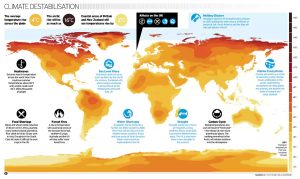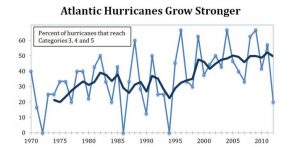A recent article published by Nature Geoscience states that limiting warming to 1.5 °C is feasible with current emission pledges (Note: emission PLEDGES, not current emission levels). What this means is that it’s not too late to avoid a 2 °C increase in average global temperatures, which itself would have disastrous consequences, but was a benchmark climatologists were hoping to avoid surpassing.
If CO2 emissions are continuously adjusted over time to limit 2100 warming to 1.5 °C, with ambitious non-CO2 mitigation, net future cumulative CO2 emissions are unlikely to prove less than 250 GtC and unlikely greater than 540 GtC. Hence, limiting warming to 1.5 °C is not yet a geophysical impossibility, but is likely to require delivery on strengthened pledges for 2030 followed by challengingly deep and rapid mitigation. Strengthening near-term emissions reductions would hedge against a high climate response or subsequent reduction rates proving economically, technically or politically unfeasible.
Climate denier sources have falsely promoted the idea that scientists have admitted that they had exaggerated global warming.
In fact, Breitbart somehow managed to translate this into:
The paper – titled Emission budgets and pathways consistent with limiting warming to 1.5 °C – concedes that it is now almost impossible that the doomsday predictions made in the last IPCC Assessment Report of 1.5 degrees C warming above pre-industrial levels by 2022 will come true.
Which is of course, false. The paper is saying that it may be possible to limit warming to 1.5 °C IF emissions are cut to the degree that emission pledges propose.






The paper’s authors have issued a response to the mischaracterization.
A number of media reports have asserted that our recent study in Nature Geoscience indicates that global temperatures are not rising as fast as predicted by the Intergovernmental Panel on Climate Change (IPCC), and hence that action to reduce greenhouse gas emissions is no longer urgent.
Both assertions are false.
Our results are entirely in line with the IPCC’s 2013 prediction that temperatures in the 2020s would be 0.9-1.3 degrees above pre-industrial (See figures 2c and 3a of our article which show the IPCC prediction, our projections, and temperatures of recent years).
What we have done is to update the implications for the amount of carbon dioxide we can still emit while expecting global temperatures to remain below the Paris Climate Agreement goal of 1.5 degrees. We find that, to likely meet the Paris goal, emission reductions would need to begin immediately and reach zero in less than 40 years’ time.
Further Reading






- Factcheck: Climate models have not ‘exaggerated’ global warming
- Right-wing media could not be more wrong about the 1.5°C carbon budget paper
- Possible good news about climate change leads to confused coverage
- Good news! Avoiding catastrophic climate change isn’t impossible yet. Just incredibly hard.
- Keeping climate change to 1.5C still possible
- Limiting Global Warming to 1.5 Degrees Celsius May Still Be Possible






